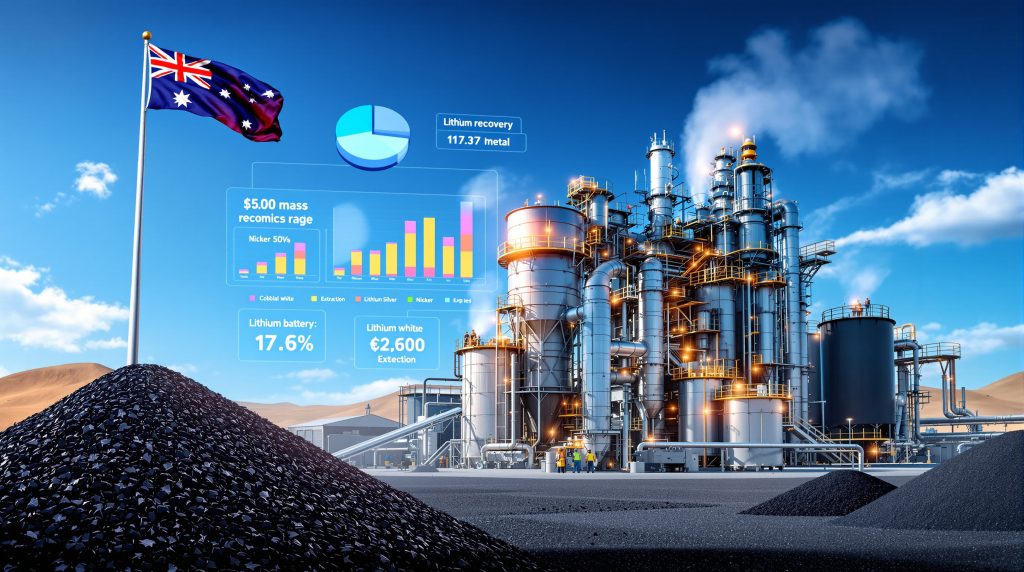Critical Mineral Recovery Through Circular Technology Systems
Australia's battery materials industry stands at the threshold of a transformative shift, with Cobalt Blue black mass recycling representing a pivotal advancement in circular economy infrastructure. This technological evolution addresses fundamental supply chain vulnerabilities while establishing new pathways for strategic mineral recovery from waste streams.
The global battery recycling landscape reveals significant opportunities for nations that can effectively process end-of-life battery materials into high-grade feedstock. Furthermore, this battery recycling breakthrough demonstrates how Australia's current position in this emerging sector requires careful examination of technological capabilities, economic drivers, and operational frameworks necessary for commercial success.
What Is Black Mass and Why Does It Matter for Critical Minerals Recovery?
Black mass represents the concentrated powder residue obtained through mechanical and chemical processing of spent lithium-ion batteries. This material contains multiple critical minerals essential for battery manufacturing, including cobalt (3-15%), nickel (5-20%), lithium (2-8%), and manganese (3-8%), alongside copper, zinc, and graphite compounds.
The International Energy Agency's Global EV Outlook 2024 projects that global lithium-ion battery recycling capacity will expand from approximately 30% recovery rates in 2023 to potentially 95%+ by 2040. This dramatic improvement reflects technological advances and economic incentives driving circular supply chain development.
Understanding Material Composition and Recovery Potential
Black mass processing offers superior feedstock characteristics compared to traditional mining operations. According to hydrometallurgical processing research published in the Journal of Cleaner Production (2024), black mass achieves 85-98% recovery rates for cobalt compared to 70-85% from primary ore processing.
Processing timelines further demonstrate efficiency advantages: black mass requires 10-25 days from feedstock to refined metal product, significantly faster than the 30-45 day timeframes typical for primary ore refining operations.
Australia's Department of Climate Change, Energy, Environment and Water indicates that less than 2% of end-of-life lithium-ion batteries are currently recycled domestically. This represents a substantial opportunity gap as global black mass generation is projected to reach 7.9 million tonnes annually by 2030.
Strategic Supply Chain Resilience Benefits
The cobalt market exemplifies the strategic importance of diversified supply sources. US Geological Survey data shows cobalt prices fluctuated 40-60% annually due to concentrated supply from the Democratic Republic of Congo. Consequently, this volatility underscores the value proposition for circular supply chains that reduce dependence on geographically concentrated primary production.
Cobalt Blue black mass recycling initiatives address this supply chain vulnerability by establishing domestic processing capabilities. The company's Commercial Manager Joel Crane emphasizes that Australia currently has only one refiner with demonstrated black mass processing capability, highlighting significant infrastructure gaps in the domestic market.
How Do Advanced Processing Technologies Extract Value from Battery Waste?
Hydrometallurgical extraction represents the predominant technology for recovering valuable metals from black mass. This process involves three critical phases: leaching, purification, and precipitation/crystallization.
Technical Processing Methodologies
The leaching phase subjects black mass to acidic or alkaline solutions, typically using:
- Sulfuric acid solutions for cobalt and nickel extraction
- Hydrochloric acid for specific metal separation
- Ammonia-based solvents for selective dissolution
- Multi-stage leaching for maximum recovery efficiency
Purification processes remove iron, manganese, and base metals through selective extraction techniques. Final precipitation produces battery-grade cobalt sulfate and other compounds suitable for cathode material manufacturing.
Commercial-scale facilities require USD 50-80 million capital investment for 5,000-10,000 tonne annual capacity, according to Battery Innovation and Recycling Council benchmarking. In addition, operating costs range from USD 3,000-5,500 per tonne of processed black mass, representing significant savings compared to primary ore refining costs of USD 4,500-7,000 per tonne.
Infrastructure Requirements and Environmental Compliance
A comprehensive battery recycling facility must meet stringent environmental standards:
| Parameter | Australian Standard | Monitoring Requirement |
|---|---|---|
| Cobalt discharge | <0.1 mg/L | Continuous wastewater monitoring |
| Nickel discharge | <0.5 mg/L | Daily effluent testing |
| Air emissions | VOC controls | National Pollutant Inventory reporting |
| Dust particulates | EPA guidelines | Ambient air quality monitoring |
Cobalt Blue's announcement regarding the Broken Hill Technology Centre represents over A$15 million in infrastructure investment since 2021, including process development, environmental systems, and quality control capabilities. This facility validates the technical feasibility of scaling demonstration plant operations to commercial production levels.
What Are the Economic Drivers Behind Black Mass Processing Investment?
Black mass feedstock pricing provides compelling economic advantages over traditional mineral sources. Current market conditions show black mass costs approximately USD 1,500-3,000 per tonne, representing 40-60% savings versus primary cobalt concentrate pricing of USD 3,500-6,500 per tonne.
Market Fundamentals and Pricing Analysis
Cobalt spot prices traded around USD 15-16 per pound on the London Metal Exchange as of November 2025, with 15-20% volatility from 12-month averages. This price instability reflects ongoing supply chain concerns and concentrated production geography.
Investment payback analysis indicates 6-10 year recovery periods under current market conditions, assuming cobalt prices at USD 15-16 per pound and 80% capacity utilization. These timelines compare favourably to traditional mining projects, which typically require 10-15 years from exploration to commercial production.
Commercial Strategic Framework
Cobalt Blue black mass recycling represents a dual-benefit strategy addressing both circular economy development and feedstock supply diversification. Joel Crane articulates this approach as providing supplementary feedstock for refinery operations until domestic mining projects commence.
The company's repositioning of the Broken Hill Technology Centre for black mass processing utilises existing demonstration plant capacity, enabling revenue generation while advancing toward Financial Investment Decision on commercial refinery operations.
However, global cobalt supply concentration creates additional economic incentives: approximately 65-70% of world refined cobalt production occurs in China, with raw material sourcing dominated by Democratic Republic of Congo operations.
How Does Australia's Regulatory Environment Support Battery Recycling Development?
Australia's Critical Minerals Strategy 2024, released in June 2024, identifies battery metals recycling as a priority sector for government support. This policy framework provides regulatory certainty for Cobalt Blue black mass recycling and similar initiatives.
The Australian Circular Battery Alliance, established in 2023, coordinates stakeholders across battery manufacturing, recycling, and government sectors. However, Australia currently lacks mandatory recycling targets for lithium-ion batteries, unlike EU directives requiring 90% recovery rates by 2030.
Environmental Approvals and Compliance Framework
Black mass processing facilities require comprehensive environmental assessments under Australia's Environmental Protection and Biodiversity Conservation Act. State-level approvals typically mandate:
- Comprehensive waste management plans
- Wastewater discharge licenses with monitoring requirements
- Air emissions control systems
- Hazardous materials handling protocols
- Regular environmental compliance reporting
Cobalt Blue gained environmental approval for its Kwinana Refinery project in September 2025, advancing the regulatory pathway for integrated cobalt refining and black mass processing operations.
Government Support Mechanisms and Incentives
Western Australia's Critical Minerals and Rare Earths Strategy provides processing incentives for facilities like Cobalt Blue's proposed Kwinana operations. Furthermore, the Australian Government's Cooperative Research Centre Program allocates funding for battery recycling research initiatives, though specific 2025 allocation figures require verification through current budget documentation.
What Operational Challenges Must Be Overcome for Commercial Success?
Scaling from demonstration to commercial operations presents significant technical and logistical challenges. Industry analysis indicates 3-5 year transition periods with 10-50x capacity increases are typical for battery recycling facilities advancing to commercial scale.
Technical Implementation Barriers
Black mass composition variability creates processing complexity, as feedstock quality varies based on:
- Original battery chemistry (lithium cobalt oxide, lithium iron phosphate, etc.)
- Battery degradation state and usage history
- Recycler processing methods and quality controls
- Contamination levels from electrolytes or separator materials
This variability requires adaptive processing parameters and sophisticated quality control systems to maintain consistent output specifications for battery-grade materials.
Supply Chain Logistics and Collection Infrastructure
Australia's battery collection infrastructure remains underdeveloped compared to international standards. The Product Stewardship (Batteries) Scheme establishes collection frameworks, but recycling remains largely voluntary without mandatory targets.
Cobalt Blue black mass recycling operations will require reliable feedstock supply from:
- Domestic battery collection networks
- Regional import opportunities from Asia-Pacific sources
- Direct partnerships with battery manufacturers and automotive companies
- Coordination with existing waste management systems
In addition, effective mining waste management strategies will be crucial for optimising the overall efficiency of these operations.
How Do Processing Economics Compare Across Different Feedstock Sources?
Economic analysis reveals significant advantages for black mass processing over traditional primary ore operations:
| Feedstock Type | Processing Cost (USD/tonne) | Metal Recovery Rate | Timeline (Days) | Environmental Impact |
|---|---|---|---|---|
| Black Mass | 3,000-5,500 | 85-95% | 10-25 | Minimal |
| Primary Ore | 4,500-7,000 | 70-85% | 30-45 | Significant |
| Mixed Feedstock | 3,500-6,000 | 80-90% | 15-35 | Moderate |
These comparisons demonstrate the economic rationale for Cobalt Blue black mass recycling as a feedstock diversification strategy. Lower processing costs combined with higher recovery rates create competitive advantages in volatile commodity markets.
Capital Allocation and Investment Considerations
Traditional mining exploration requires substantial capital investment with uncertain returns and extended development timelines. Black mass processing facilities offer:
- Faster time-to-revenue (2-3 years versus 10+ years for mining)
- Lower capital intensity for initial operations
- Scalable expansion opportunities based on feedstock availability
- Reduced regulatory and environmental approval complexity
Consequently, risk profiles favour recycling operations due to predictable feedstock costs and established market demand for processed materials.
What Are the Long-Term Strategic Implications for Australia's Mining Sector?
Cobalt Blue black mass recycling represents broader transformation opportunities within Australia's traditional mining sector. Integration of recycling with conventional mining operations creates synergistic advantages through established infrastructure and expertise.
Technology Export Potential and Regional Hub Development
Australia's development of battery recycling capabilities positions the nation as a potential technology exporter for processing equipment and expertise. The Asia-Pacific region's projected 250,000-400,000 tonnes annually of black mass availability by 2030 creates substantial market opportunities.
Regional hub development could leverage Australia's:
- Established mining sector expertise and infrastructure
- Geographic proximity to major battery manufacturing centres
- Stable regulatory environment and rule of law
- Advanced research and development capabilities
Workforce Transition and Skills Development
The transition from extraction-focused to processing-focused operations requires workforce development initiatives. Technical skills for hydrometallurgical processing, environmental management, and quality control systems represent priority training areas.
Recent reports suggest Joel Crane's observation that other refiners should follow Cobalt Blue's lead indicates significant opportunity for industry expansion and employment growth in battery materials processing.
How Will Black Mass Processing Scale to Meet Future Demand?
Projected demand scenarios indicate substantial growth potential for Cobalt Blue black mass recycling operations. Global electric vehicle adoption rates and battery deployment across energy storage applications drive end-of-life battery availability projections.
Production Capacity Planning and Market Development
Commercial viability requires coordination between:
- Domestic battery collection infrastructure development
- Regional feedstock import opportunities
- Processing facility capacity expansion
- Integration with planned refinery operations
Technology advancement needs focus on improved efficiency, automated sorting systems, and enhanced metal recovery rates. Research initiatives through universities and government-funded programs support these development priorities.
Competitive Positioning and Market Share
Australia's first-mover advantage in regional black mass processing creates opportunities for market leadership. However, competition from international recycling facilities requires continuous technological advancement and cost optimisation.
For instance, battery metals investment strategies must consider success metrics including metal recovery rates by element type, processing cost per tonne, product quality consistency, and environmental impact reduction achievements.
What Success Metrics Define Effective Black Mass Recycling Operations?
Commercial success in Cobalt Blue black mass recycling requires achieving specific performance benchmarks:
Key Performance Indicators and Benchmarking
- Metal Recovery Rates: Target >90% for cobalt, >85% for nickel and lithium
- Processing Costs: Maintain <USD 4,000 per tonne of black mass processed
- Product Quality: Achieve battery-grade specifications consistently
- Environmental Performance: Zero discharge violations and minimal waste generation
- Capacity Utilisation: Sustain >75% facility utilisation rates
International best practice comparisons show leading facilities achieving 95%+ recovery rates for primary metals while maintaining strict environmental compliance standards.
Commercial Viability Assessments
Financial sustainability requires balancing feedstock costs, processing expenses, and market pricing for refined materials. Cobalt Blue black mass recycling benefits from existing infrastructure investments at the Broken Hill Technology Centre, reducing capital requirements for initial operations.
Regulatory compliance performance maintains operational licences and community support necessary for long-term facility operations.
Positioning Australia as a Global Battery Recycling Leader
Australia's strategic advantages in battery recycling include first-mover positioning in regional black mass processing, integration opportunities with existing mining expertise, and supportive regulatory environments for circular economy development.
Cobalt Blue black mass recycling demonstrates the technical feasibility and economic viability of domestic battery materials processing. The company's A$15 million investment in demonstration plant operations validates processing technologies while establishing operational capabilities for commercial expansion.
Implementation Roadmap and Strategic Priorities
Near-term priorities focus on optimising demonstration operations, securing reliable feedstock supply arrangements, and advancing toward Financial Investment Decision for integrated refinery operations.
Medium-term objectives include commercial scale deployment, technology transfer to additional facilities, and establishment of comprehensive battery collection networks.
Long-term integration with Australia's broader critical minerals strategy positions battery recycling as a cornerstone of domestic supply chain resilience and circular economy development.
The geographic proximity to major battery manufacturing centres in Asia creates export opportunities for processed materials, while domestic demand growth from electric vehicle adoption supports market expansion. However, industry innovation trends will continue to shape the competitive landscape and technological requirements for success.
Disclaimer: This analysis is based on publicly available information and industry research. Investment decisions should consider comprehensive due diligence including company-specific financial data, market conditions, and regulatory developments. Battery recycling operations involve technical and commercial risks that may affect project outcomes and financial returns.
Looking to Capitalise on Australia's Battery Recycling Revolution?
Discovery Alert's proprietary Discovery IQ model delivers instant notifications on significant ASX mineral discoveries, including breakthrough developments in critical minerals and battery materials processing. Stay ahead of emerging opportunities in Australia's evolving circular economy sector by exploring Discovery Alert's dedicated discoveries page, which showcases historic examples of how major mineral discoveries can generate substantial market returns.




